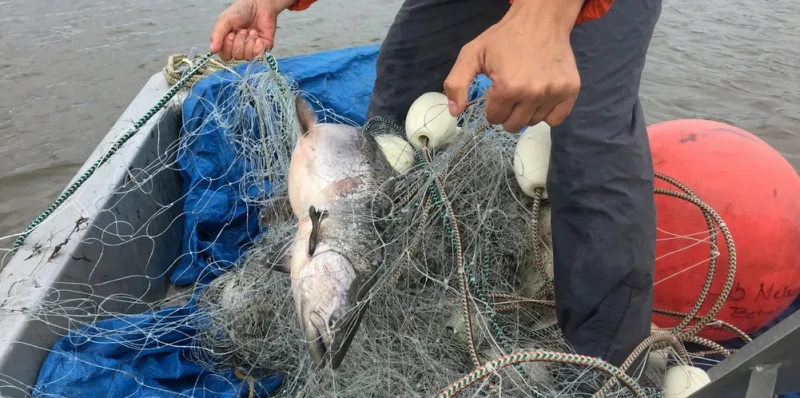Alaska Native groups and others hope two new bills by Rep. Mary Peltola, D, will go where present fishery management plans haven’t gone before and cut down on salmon bycatch in the Bering Sea. The announcements of “The Bottom Trawl Clarity Act” and the “Bycatch Reduction and Mitigation Act” will reduce the incidental harvest of chinooks, chums, and other salmon destined for western Alaska watersheds.
The region has experienced abysmal salmon returns in recent years and wants trawlers to improve their bycatch reduction efforts.
“Subsistence and commercial fisheries throughout Western Alaska have been shuttered in recent years,” said Kevin Whitworth, executive director of the Kuskokwim Inter-Tribal Fish Commission, in a press release put out by SalmonState. “With record-low escapements and few (if any) opportunities for Indigenous and rural fishing families to harvest salmon, there is nothing more that our communities can sacrifice to protect salmon.”
The Bottom Trawl Clarity Act strives to define how trawl gear touches the ocean floor. Though pollock trawls have been hallowed as midwater nets, some studies show that they are towed along the bottom-most of the time. This act would distinguish “substantial” and “limited” times that the trawls hug bottom, then designate “Bottom Trawl Zones” where it would be allowed.
Meanwhile, the Bycatch Reduction and Mitigation Act will appropriate more than $15 million to help fund new projects hosted by NOAA’s Bycatch Reduction and Engineering Program to learn new ways to cut down on the number of salmon taken in trawls.
The bills are the latest reverberations in regional efforts to curb bycatch. Earlier this year NOAA rejected a request for emergency action to close the pollock trawl fishery in January and impose a zero cap on chinook salmon bycatch in the Bering Sea trawl fisheries. Five major fishing groups representing western Alaska communities and commercial and subsistence fishermen on the Yukon and Kuskokwim Rivers proposed the plan on January 17, three days before the season.
Two groups, Tanana Chiefs Conference and Alaska Village Council Presidents, did not respond to requests for interviews for this story, but in an earlier letter to NOAA argued that the bycatch of chinooks in trawls coupled with catastrophically low returns to western Alaska drainages warranted emergency action under the Magnuson-Stevens Act the North Pacific Fishery Management Council and the Department of Commerce.
While NOAA concurred that the dire conditions of the salmon met some criterion within the policy for emergency action—and allowed the circumvention of some procedural requirements— the request did not meet all ten national standards, specifically National Standard 9.
National Standard 9 includes clauses stating that the government “shall, to the extent practicable, (A) minimize bycatch and (B) to the extent bycatch cannot be avoided, minimize the mortality of such bycatch.”
In its review, NOAA noted that taking action would effectively close the pollock fishery for the first 180 days; moreover, that closure would cause devastating economic ripples throughout the industry with no guarantee of rebuilding the ailing population of chinooks.
“Based on our review of the best available scientific information, the petition did not meet all three required criteria,” said the NOAA response on April 18. “Most notably, the circumstances do not establish that the requested action would effectively resolve the Chinook salmon crisis in rivers in Western and Interior Alaska.
“Instituting a cap of zero Chinook salmon bycatch in the Bering Sea pollock fishery would effectively close the largest fishery in the United States. It would adversely impact the people, organizations, and communities who rely on it, including Community Development Quota groups that provide substantial benefits to underserved communities.”
Peltola’s bills will go through various reviews in the months ahead, and in the vein of most federal fishery management issues they will likely face contest from the fishing industry and various scientific communities.
“This legislation will harm America’s fishermen, says Stephanie Madsen, executive director of the At-Sea Processors Association in Seattle. “It will harm Alaska fishermen and fishermen around the country. It would undermine the council process, and will constrain scientists and managers from using the best available science. This bill has national implications and others should take note that their lives will be negatively impacted if this legislation becomes law.”
Given the complexity of the pollock trawl and salmon bycatch issue congressional action may not yield results much sooner than fishery management motions already in play. To some, the answer lies in revisiting emergency action by NOAA.
“The introduction of Rep. Peltola’s bill is the beginning of a long and complicated process via Congress,” says Mary Martin, communications director with SalmonState, in Juneau. “But right now, the Administration can and should take action to update the implementation of three of the National Standards in the Magnuson-Stevens Fisheries Act, which will immediately have a positive impact on Alaskans’ lives and livelihoods.”







